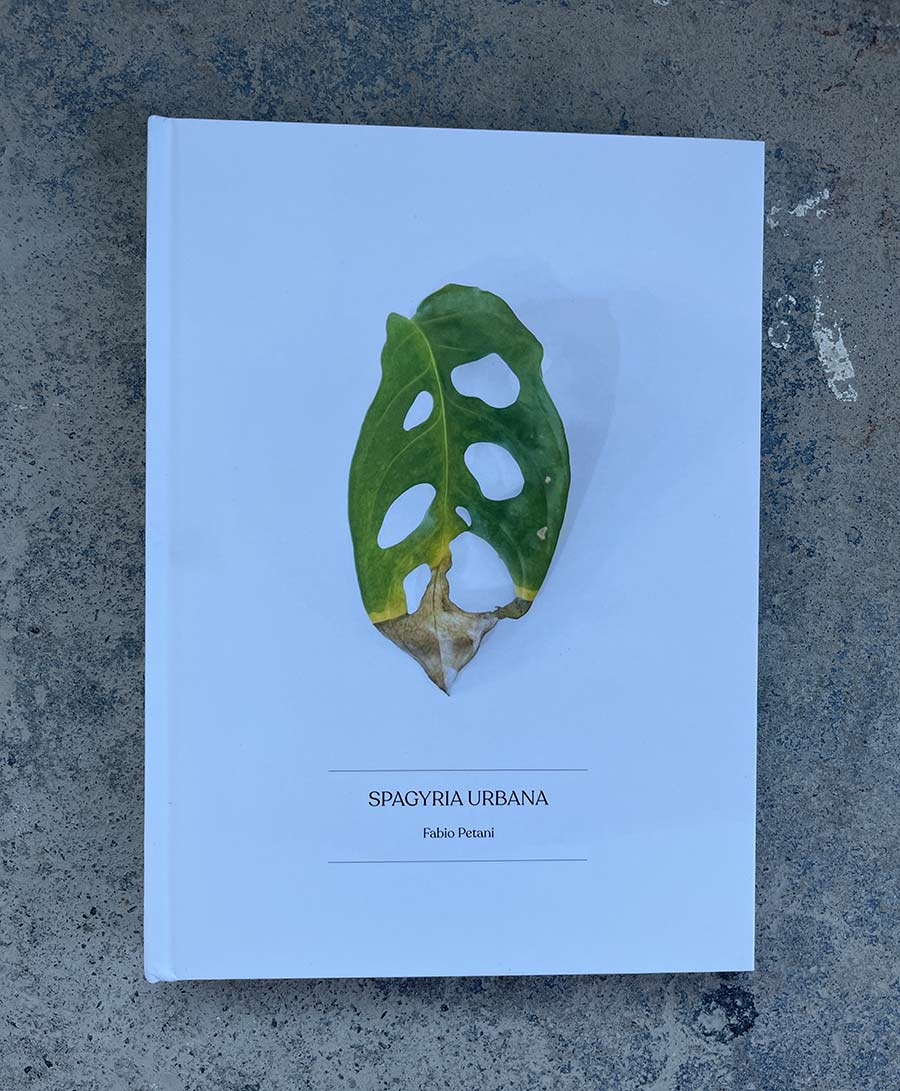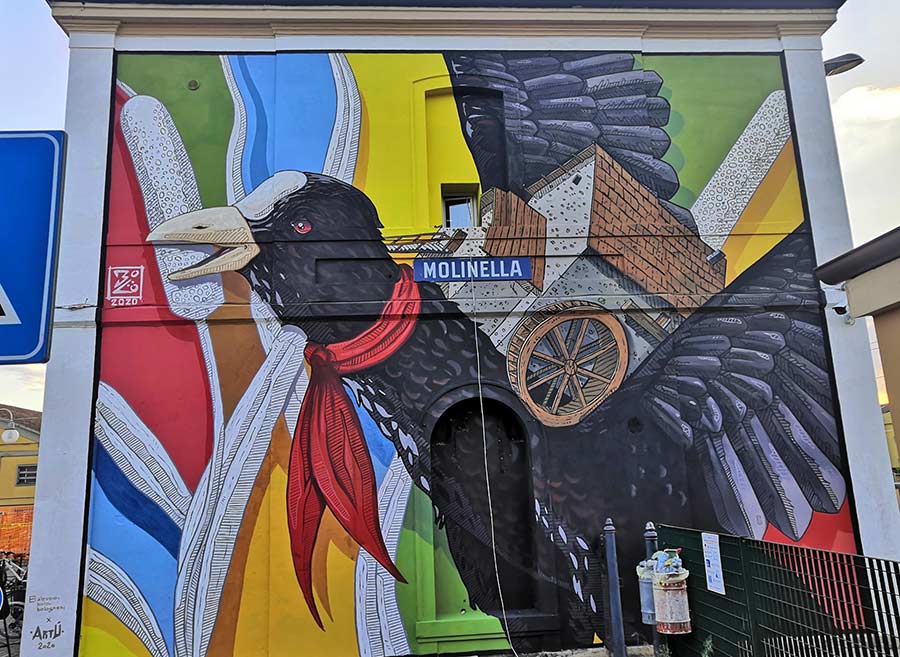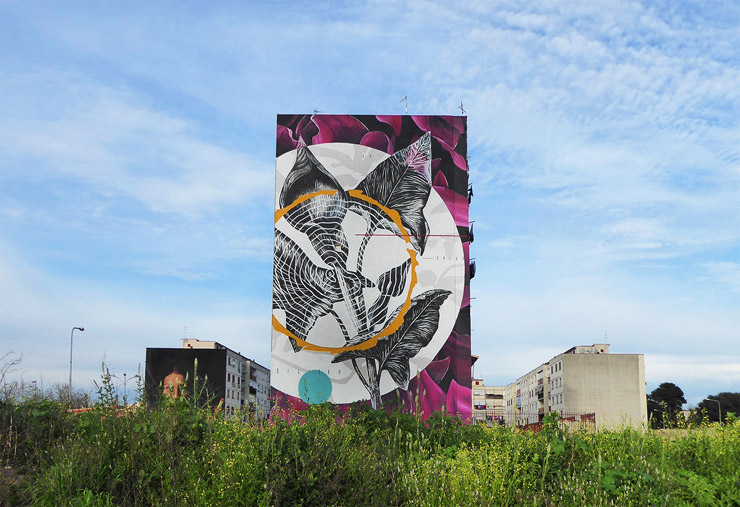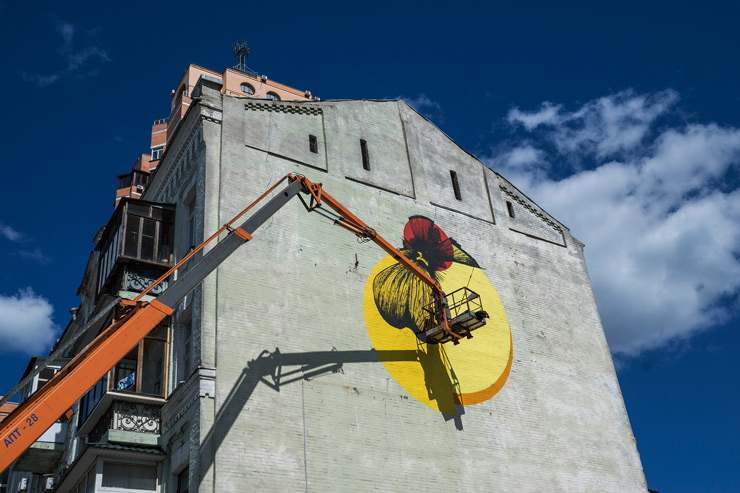UPEART 2018 in Finland took place during the month of September including 20 international and local artists in 12 different cities across the country.

Case Maclaim. Detail. UPEArt Finland 2018. Espoo, Finland. September 2018. (photo © Jaime Rojo)
Today we give you a recap of some favorite scenes from the festival across many cities of Finland thanks to the vision and organizing of Jorgos Fanaris and his team who collectively direct the festival from their headquarters in a post-industrial neighborhood of Helsinki. While there is a proud graff scene and history here, and the city has areas like the Pasila Street Art District, the capital is usually known as a sparkling international city of islands and a peninsula by the Gulf of Finland facing Tallinn, Estonia across the bay.
Proudly humble, elegant and rationally romantic, the city is flanked on all sides by arts and culture, low and high, with historical art institutions like the National Museum as well as the more contemporary Kiasma and cross disciplinary Kunsthalle Helsinki. A deeper rooted cultural history is also apparent in the traditional wooden architecture, the influence of its neighbors Sweden and Russia, and its ability even today to evolve with the most modern of global design practice.

Case Maclaim. Detail. UPEArt Finland 2018. Espoo, Finland. September 2018. (photo © Jaime Rojo)
For urban explorers like ourselves who wander the margins and explore the forgotten, neglected parts of the metropolis, it was a bit of a shock to see 8 charming Finnish cities and towns in only a few days – interspersed with millions of birch tree forests and sweeping vistas of farmland, with Russia visible at one point just across a canal.
We drove from uncongested towns surrounded by woodlands like Joensuu and Hyvinkää to midsized cities like Tampere and Espoo, using a stick shift Volkswagen and minding the speed cameras on a smooth and well maintained system of roads and highways. Usually we’re looking out for rats and broken glass and homeless drug users, not slow-moving farming tractors and wily-eyed moose who may cross your path.

Case Maclaim. UPEArt Finland 2018. Espoo, Finland. September 2018. (photo © Jaime Rojo)
But the murals! Choosing from among some of the most accomplished painters and planners of design in the current international scene, Fanaris relies on his own history with graffiti, hip hop, and perhaps the Finnish National Opera when selecting participants to invite.
The quality is high in many instances throughout the mural program and municipalities are gifted with some works may prove timeless – until they fade. Perhaps more decorative than transgressive as a whole, these are public works made in collaboration with local tastes. Some meanings are buried beneath layers, others more obvious and on the surface. An unrealized irony of many “legit” mural programs like this one is many of these artists used to do the illegal stuff too.
As UPEART travels and evolves it will be interesting to see how it changes. Fanaris tells us that the future will include installations, sculpture, even performance as the festival becomes more integrated with communities. With a solid foundation of curation on a massive country-wide scale in these first three years, we look forward to see where UPEART moves next.

Mantra. UPEArt Finland 2018. Hyvinkää, Finland. September 2018. (photo © Jaime Rojo)
“When I was a child I was not curious about painting,” Mantra says, “I was more curious about what I could find in the garden so that’s why I spent a lot of time studying these insects and these animals.” Later he shows us images of butterflies and other winged creatures rendered in high fidelity inside decaying factory rooms, including a large dead bird lying on its side. “I painted this because I had seen a dead bird in the garden only a week before.”
Read more: Mantra in Hyvinkää for UPEART Festival 2018 Finland – Dispatch 5

Mantra. Detail. UPEArt Finland 2018. Hyvinkää, Finland. September 2018. (photo © Mantra)

Mantra. UPEArt Finland 2018. Hyvinkää, Finland. September 2018. (photo © Mantra)

Sainer. UPEArt Finland 2018. Helsinki, Finland. September 2018. (photo © Jaime Rojo)
“I think my work is changing recently,” he says. “I have liked to do plainer paintings – like small landscapes . I’m not really into the characters that much in the same way that I was. When I do paint characters they are in the shadow. I like the idea of making portraits where the portrait is not the most important part of the painting.”
BSA: That’s so anti-intuitive – because normally that would be the center focal point, right?
Sainer: Yes – even here the portrait is central but I am trying to play all around it just to hide it. It’s just one of the ideas that I am trying to work with these days.
Read more from our interview with Sainer here.

Sainer. UPEArt Finland 2018. Helsinki, Finland. September 2018. (photo © Jaime Rojo)

Waone. Detail. UPEArt Finland 2018. Kotka, Finland. September 2018. (photo © Jaime Rojo)
Ukrainian artist Waone, of Interesni Kazki titled his mural “Spirit of Antique Book”.
“Reading the real book in the age of technology and internet may look rare and a kind of old fashioned, but not for me,” he says. “This mural ‘Spirit of Antique Book’ I dedicated to all book lovers. It represents the wonderful way to escape from ordinary life to extraordinary worlds, and depicts that magic moment when you read the book and lose yourself between the pages.”
BSA: Does it concern you that school children today are becoming unfamiliar with reading traditional books on paper?
Waone: Hmm I didn’t think about books in schools, in Ukraine we still use “normal” books… But I’m sure normal books will become more and more rare. I don’t judge it and I’m not saying that’s good or bad. I just love the book esthetic, a strong symbol of knowledge.”
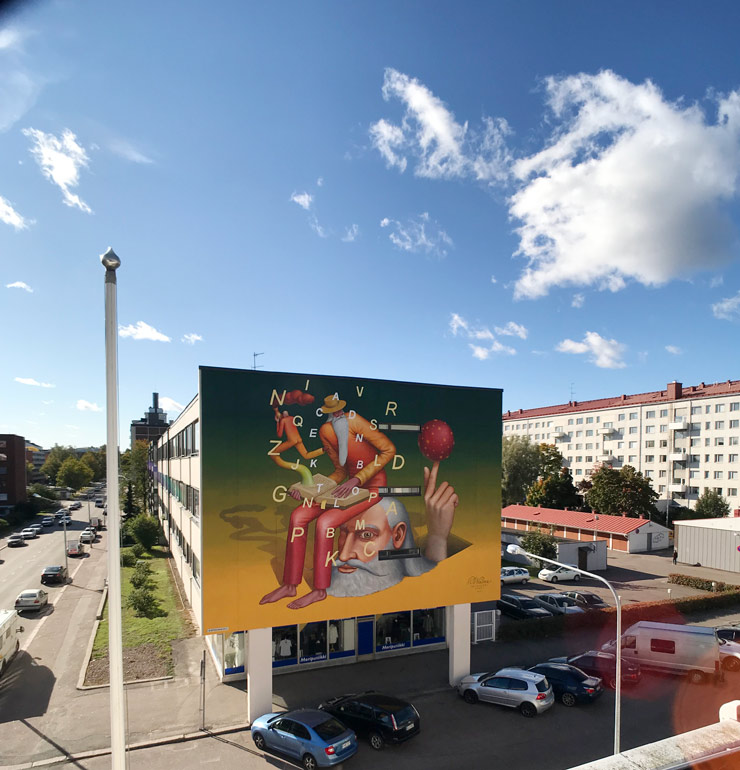
Waone. UPEArt Finland 2018. Kotka, Finland. September 2018. (photo © Jaime Rojo)

Natalia Rak. Detail. UPEArt Finland 2018. Joensuu, Finland. September 2018. (photo © Jaime Rojo)

Natalia Rak. UPEArt Finland 2018. Joensuu, Finland. September 2018. (photo © Jaime Rojo)

Sepe. UPEArt Finland 2018. Jyväskylä, Finland. September 2018. (photo © Jaime Rojo)

David De La Mano. Detail. UPEArt Finland 2018. Jyväskylä, Finland. September 2018. (photo © Jaime Rojo)

David De La Mano. UPEArt Finland 2018. Jyväskylä, Finland. September 2018. (photo © Jaime Rojo)
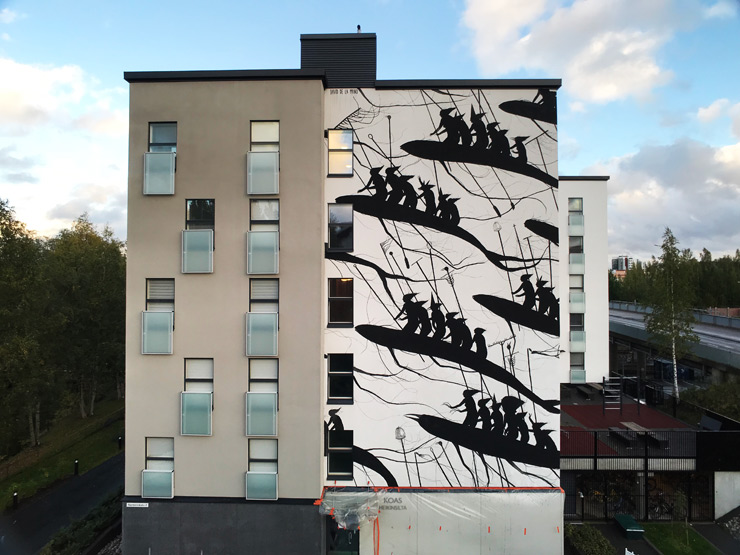
David De La Mano. Detail. UPEArt Finland 2018. Jyväskylä, Finland. September 2018. (photo © Jaime Rojo)

Helen Bur. UPEArt Finland 2018. Kotka, Finland. September 2018. (photo © Jaime Rojo)

Eero Lampinen. Work in progress. UPEArt Finland 2018. Helsinki, Finland. September 2018. (photo © Jaime Rojo)
Of his own work, he says, “It’s like a mix of fantasy with contemporary and realistic elements – kind of magic realism. I like to play around with fashion different types of characters.”
The characters are here in the evolving mural – three figures who are working the runways of the street in distinctly different styles.
“There is a night demon, a rubber-outfit person, and then an older character,” he says, “They are all walking separate ways in the streets – and it plays around with this street.”
Read more with Eero Lampinen here.

Eero Lampinen. UPEArt Finland 2018. Helsinki, Finland. September 2018. (photo © Eero Lampinen)

Pertti Jarla. UPEArt Finland 2018. Tampere, Finland. September 2018. (photo © Jaime Rojo)

Fabio Petani. Detail. UPEArt Finland 2018. Salo, Finland. September 2018. (photo © Jaime Rojo)

Fabio Petani. Detail. UPEArt Finland 2018. Salo, Finland. September 2018. (photo © Jaime Rojo)

Fabio Petani. UPEArt Finland 2018. Salo, Finland. September 2018. (photo © Jaime Rojo)

How & Nosm. Detail. UPEArt Finland 2018. Lisalmi, Finland. September 2018. (photo © Jaime Rojo)

How & Nosm. UPEArt Finland 2018. Lisalmi, Finland. September 2018. (photo © Jaime Rojo)

Leon Keer. UPEArt Finland 2018. Salo, Finland. September 2018. (photo © Jaime Rojo)

Leon Keer. UPEArt Finland 2018. Salo, Finland. September 2018. (photo © Jaime Rojo)

Robert Proch. Detail. UPEArt Finland 2018. Joensuu, Finland. September 2018. (photo © Jaime Rojo)
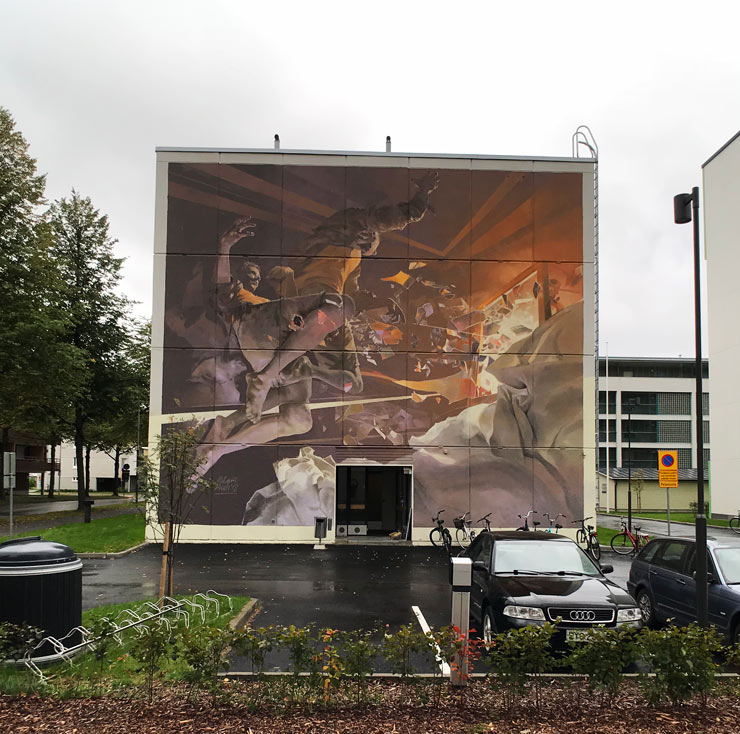
Robert Proch. UPEArt Finland 2018. Joensuu, Finland. September 2018. (photo © Jaime Rojo)

Isaac Cordal. UPEArt Finland 2018. Espoo, Finland. September 2018. (photo © Jaime Rojo)
Isaac Cordal made a number of interesting installations in Karakallio in Espoo, including a haunting series of small buildings attached on trees throughout the forest.
Read more about Isaac Cordal at UPEA Art Festival 2018 – Finland. Dispatch 3

Isaac Cordal. UPEArt Finland 2018. Espoo, Finland. September 2018. (photo © Jaime Rojo)

Isaac Cordal. UPEArt Finland 2018. Espoo, Finland. September 2018. (photo © Jaime Rojo)

Isaac Cordal. UPEArt Finland 2018. Espoo, Finland. September 2018. (photo © Jaime Rojo)

Isaac Cordal. UPEArt Finland 2018. Espoo, Finland. September 2018. (photo © Jaime Rojo)
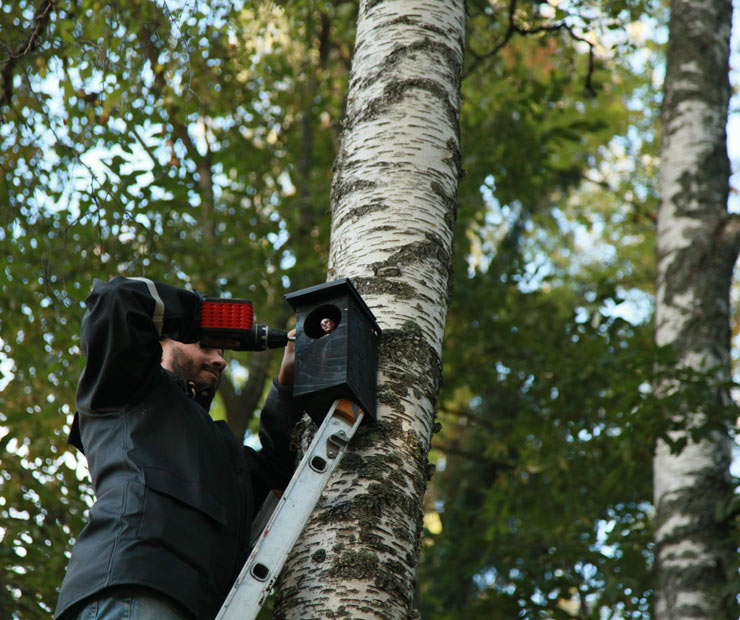
Isaac Cordal. UPEArt Finland 2018. Espoo, Finland. September 2018. (photo © Jaime Rojo)

Isaac Cordal. UPEArt Finland 2018. Espoo, Finland. September 2018. (photo © Jaime Rojo)
NOTE: No trees were damaged by installing the birdhouse sculptures on them.
All the participating artists on UPEArt 2018 are: Andrew Hem, Case Maclaim, David De La Mano, Eero Lampinen, Fabio Petani, Gummy Gue, Helen Bur, How & Nosm, Isaac Cordal, Jussi Twoseven, Kenor, Leon Keer, Mantra, Natalia Rak, Pertti Jarla, Robert Proch, Sainer, Sepe, Silja Selonen and Waone.

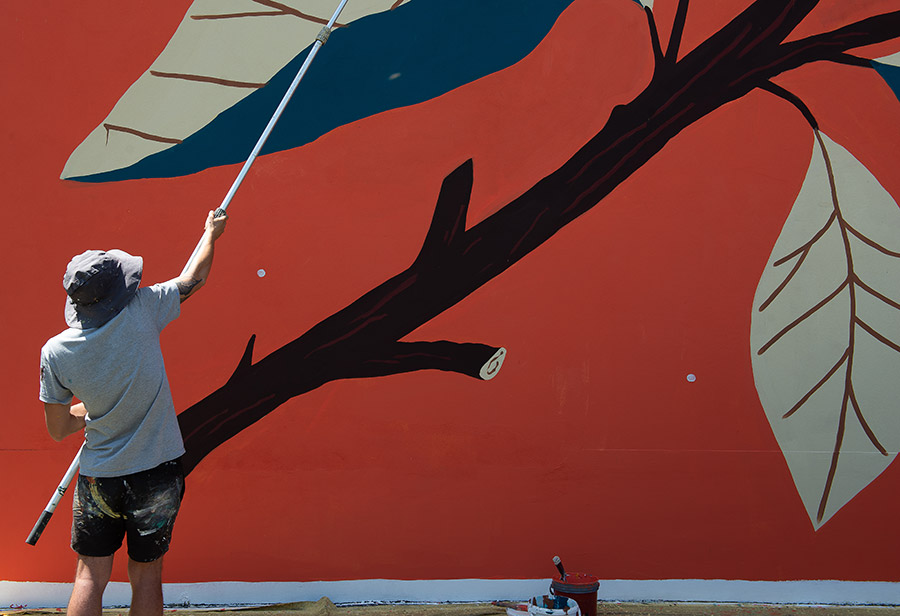







 BROOKLYN STREET ART LOVES YOU MORE EVERY DAY
BROOKLYN STREET ART LOVES YOU MORE EVERY DAY

